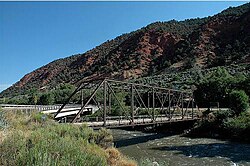Tributary
For the stream in Tennessee see Roaring Fork (Great Smoky Mountains)
Roaring Fork River Hardwick Bridge crossing the Roaring Fork River, between Carbondale and Glenwood Springs Location Country United States State Colorado Physical characteristics Source Independence Lake • location White River National Forest , Pitkin County • coordinates 39°08′38″N 106°34′04″W / 39.14389°N 106.56778°W / 39.14389; -106.56778 • elevation 12,490 ft (3,810 m)
Mouth Colorado River • location Glenwood Springs , Garfield County • coordinates 39°32′57″N 107°19′47″W / 39.54917°N 107.32972°W / 39.54917; -107.32972 • elevation 5,718 ft (1,743 m) Length 70 mi (110 km) Basin size 1,453 sq mi (3,760 km) Discharge • location mouth • average 1,206 cu ft/s (34.2 m/s) • minimum 180 cu ft/s (5.1 m/s) • maximum 13,000 cu ft/s (370 m/s)
Basin features Tributaries • left Crystal River • right Fryingpan River
Roaring Fork River is a tributary of the Colorado River , approximately 70 miles (110 km) long, in west central Colorado in the United States . The river drains a populated and economically vital area of the Colorado Western Slope called the Roaring Fork Valley or Roaring Fork Watershed, which includes the resort city of Aspen and the resorts of Aspen/Snowmass .
The Roaring Fork in winter as seen from a backyard in Woody Creek, Colorado . It rises in the Sawatch Range in eastern Pitkin County , on the west side of Independence Pass on the continental divide . It flows northwest past Aspen, Woody Creek , and Snowmass . It receives the Fryingpan River at Basalt . 1.5 miles (2 km) below Carbondale , it receives the Crystal River from the south. It joins the Colorado in Glenwood Springs . The entire area that drains into the Roaring Fork River is known as the Roaring Fork Watershed. This area is 1,451 square miles (3,760 km) and about the same size as the state of Rhode Island. The river flows through canyons along most of its route and is a popular destination for recreation whitewater rafting . The river supplies water through the Sawatch Range to the Twin Lakes Reservoir via the Twin Lakes Tunnel . Roaring Fork Conservancy is the watershed conservation organization for the Roaring Fork River and its tributaries.
The Roaring Fork is a swift, deep, powerful river with very clear water. It is navigable by small craft throughout most of its length to its confluence with the Colorado. The mean annual flow is 1,206 cu ft/s (34.2 m/s).
See also
References
^ "Roaring Fork River" . Geographic Names Information System United States Geological Survey , United States Department of the Interior . Retrieved 2011-01-27.
^ "USGS Gage #09085000 on the Roaring Fork River at Glenwood Springs, CO" (PDF). National Water Information System . U.S. Geological Survey. 1905–2011. Retrieved 2012-02-27.
External links
Categories :
Text is available under the Creative Commons Attribution-ShareAlike License. Additional terms may apply.
**DISCLAIMER** We are not affiliated with Wikipedia, and Cloudflare.
The information presented on this site is for general informational purposes only and does not constitute medical advice.
You should always have a personal consultation with a healthcare professional before making changes to your diet, medication, or exercise routine.
AI helps with the correspondence in our chat.
We participate in an affiliate program. If you buy something through a link, we may earn a commission 💕
↑
 Hardwick Bridge crossing the Roaring Fork River, between Carbondale and Glenwood Springs
Hardwick Bridge crossing the Roaring Fork River, between Carbondale and Glenwood Springs Map of the Roaring Fork River
Map of the Roaring Fork River




